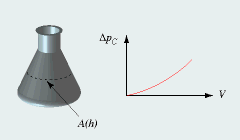CHAPTER 1 > ACTIVITIES > PROBLEMS > PROBLEM 3
Elastance and capacitance of a beaker
Water is filled into a large glass beaker and the pressure of the water at the bottom of the tank is measured (see the table on the right).In the accompanying data sheet (see the file => Pressure_Volume.xls), volume and pressure data for the beaker is reported.Dimensions of beaker: Bottom radius: 13.0 cm; radius at a height of 10.3 cm: 6.62 cm. | | |
V / ml | p / mbar |
0 | 978.0 |
1000 | 979.7 |
1500 | 980.9 |
2000 | 982.2 |
2500 | 983.8 |
3000 | 985.6 |
3300 | 986.8 |
3500 | 987.7 |
3600 | 988.1 |
